Closed heating in a private house
In the past few years, a closed heating system has become more and more popular. Heating equipment is becoming more and more expensive, and we want it to last longer. In closed-type systems, the possibility of free oxygen getting inside is practically excluded, which prolongs the life of the equipment.
The content of the article
Closed heat supply system - what is it
As you know, in any heating system of a private house there is an expansion tank. This is a container that contains some weaning of the coolant. This tank is required to compensate for thermal expansion under various operating conditions. By design, expansion tanks are open and closed, respectively, and heating systems are called open and closed.
In recent years, it is the closed heating circuit that has become more and more popular. First, it is automated and works without human intervention for a long time. Secondly, any type of coolant can be used in it, including antifreezes (it evaporates from open tanks). Thirdly, the pressure is kept constant, which makes it possible to use any household appliances in a private house. There are a few more pluses that relate to wiring and operation:
- There is no direct contact of the coolant with air, therefore, there is no (or almost no) incoherent oxygen, which is a powerful oxidizing agent. This means that the heating elements will not oxidize, which will increase their service life.
- The closed-type expansion tank is placed anywhere, usually not far from the boiler (wall-mounted gas boilers come immediately with expansion tanks). An open-type tank should be in the attic, and these are additional pipes, as well as insulation measures so that heat does not "leak" through the roof.
- In a closed system, there are automatic air vents, so there is no airing.
In general, a closed heating system is considered more convenient. Its main drawback is volatility. The movement of the coolant is provided by a circulation pump (forced circulation), and it does not work without electricity. Natural circulation in closed systems can be organized, but it is difficult - flow regulation is required using the thickness of the pipes. This is a rather complicated calculation, because it is often believed that a closed heating system works only with a pump.
To reduce volatility and increase the reliability of heating, uninterruptible power supplies with batteries and / or small generators are installed, which will provide emergency power supply.
Components and their purpose
In general, a closed heating system consists of a specific set of elements:
- Boiler with safety group. There are two options here. First, a safety group is built into the boiler (gas wall-hung boilers, pellet boilers and some solid fuel gas generators). The second - there is no safety group in the boiler, then it is installed at the outlet in the supply pipeline.
- Pipes, radiators, water heated floor, convectors.
- Circulation pump. Provides the movement of the coolant. It is installed mainly on the return pipeline (here the temperature is lower and there is less possibility of overheating).
- Expansion tank.Compensates for changes in the volume of the coolant, maintaining a stable pressure.
Now more about each element.
Boiler - which one to choose
Since the closed heating system of a private house can work in autonomous mode, it makes sense to install a heating boiler with automation. In this case, having adjusted the parameters, you do not need to return to this. All modes are supported without human intervention.
The most convenient gas boilers in this regard. They have the option of connecting a room thermostat. The temperature set on it is maintained with an accuracy of one degree. She fell by a degree, the boiler turned on, heating the house. As soon as the thermostat is triggered (temperature reached), operation stops. Comfortable, convenient, economical.
Some models have the ability to connect weather-dependent automation - these are external sensors. According to their readings, the boiler adjusts the power of the burners. Gas boilers in closed heating systems are good equipment that can provide comfort. The only pity is that gas is not available everywhere.
Electric boilers can provide no less degree of automation. In addition to traditional units, induction and electrode units have recently appeared on heating elements. They are distinguished by their compact size and low inertia. Many believe that they are more economical than boilers with heating elements. But even this kind of heating units can not be used everywhere, since power outages in winter are a frequent occurrence in many regions of our country. And to provide power to the boiler. 8-12 kW from a generator is a very difficult matter.
Boilers for solid or liquid fuels are more versatile and independent in this regard. An important point: for the installation of a liquid fuel boiler, a separate room is required - this is a requirement of the fire department. Solid fuel boilers can stand in the house, but this is inconvenient, since a lot of debris falls from the fuel during the heating.
Modern solid fuel boilers, although they remain intermittent equipment (they heat up during the fire, cool off when the bookmark is burnt out), but they also have automation, which allows you to maintain a given temperature in the system by adjusting the intensity of combustion. Although the degree of automation is not as high as that of gas or electric boilers, it is there.
Pellet boilers are not very common in our camp. In fact, this is also a solid fuel, but boilers of this type operate in a continuous mode. Pellets are automatically fed into the firebox (until the stock in the burker is finished). With good fuel quality, ash cleaning is required once every few weeks, and all operating parameters are controlled by automation. The distribution of this equipment is held back only by its high price: manufacturers are mainly European, and their prices are corresponding.
A little about calculating the boiler power for closed-type heating systems. It is determined according to the general principle: for 10 sq. meters of area with normal insulation take 1 kW of boiler power. Only take "back to back" is not advised. First, there are abnormally cold periods during which you may not have enough design capacity. Secondly, operation at the power limit leads to rapid equipment wear. Therefore, it is advisable to take the boiler power for the system with a margin of 30-50%.
Security group
A safety group is installed on the supply pipeline at the outlet of the boiler. She must control his work and system parameters. Consists of pressure gauge, automatic air vent and safety valve.
The pressure gauge makes it possible to monitor the pressure in the system.According to the recommendations, it should be in the range of 1.5-3 Bar (in one-story houses it is 1.5-2 Bar, in two-story houses - up to 3 Bar). In case of deviation from these parameters, appropriate measures must be taken. If the pressure has dropped below normal, it is necessary to check if there is a leak, and then add a certain amount of coolant to the system. With increased pressure, everything is somewhat more complicated: it is necessary to check in which mode the boiler is operating, whether it has overheated the coolant. The operation of the circulation pump, the correct operation of the pressure gauge and the safety valve are also checked. It is he who must dump the excess coolant when the pressure threshold is exceeded. A pipe / hose is connected to the free branch pipe of the safety valve, which is discharged into the sewer or drainage system. Here it is better to do so that it is possible to control whether the valve is triggered - with frequent water discharge, it is necessary to look for the causes and eliminate them.
The third element of the group is an automatic air vent. Air trapped in the system is removed through it. A very convenient device that allows you to get rid of the problem of air congestion in the system.
Security groups are sold assembled (pictured above), or you can buy all devices separately and connect them using the same pipes that made the system wiring.
Expansion vessel for closed heating system
The expansion tank is designed to compensate for the change in the volume of the coolant depending on the temperature. In closed heating systems, this is a sealed container, divided into two parts by an elastic membrane. The upper part contains air or inert gas (in expensive models). While the temperature of the coolant is low, the tank remains empty, the membrane is straightened (in the figure, the picture on the right).
When heated, the coolant increases in volume, its excess rises into the tank, pushing the membrane and squeezing the gas pumped into the upper part (in the picture on the left). This is displayed on the pressure gauge as an increase in pressure and can serve as a signal to reduce the intensity of combustion. Some models have a relief valve that relieves excess air / gas when the pressure threshold is reached.
As the coolant cools down, the pressure in the upper part of the tank squeezes the coolant out of the tank into the system, the manometer readings return to normal. That's the whole principle of operation of a membrane-type expansion tank. By the way, there are two types of membranes - disc-shaped and pear-shaped. The shape of the membrane does not affect the principle of operation.
Volume calculation
According to generally accepted standards, the volume of the expansion tank should be 10% of the total volume of the coolant. This means that you have to calculate how much water will fit in the pipes and radiators of your system (it is in the technical data of the radiators, but the volume of the pipes can be calculated). 1/10 of this figure will be the volume of the required expansion tank. But this figure is valid only if the coolant is water. If an anti-freeze fluid is used, the tank size is increased by 50% of the calculated volume.
Here is an example of calculating the volume of a membrane tank for a closed heating system:
- the volume of the heating system is 28 liters;
- the size of the expansion tank for the system filled with water is 2.8 liters;
- the size of the membrane tank for a system with an anti-freeze liquid is 2.8 + 0.5 * 2.8 = 4.2 liters.
When buying, choose the nearest larger volume. Do not take the smaller one - it is better to have a small margin.
What to look for when buying
Stores have red and blue cisterns. Red cisterns are suitable for heating. Blue are structurally the same, only they are designed for cold water and do not tolerate high temperatures.
What else to look for? There are two types of tanks - with a replaceable membrane (they are also called flanged) and with a non-replaceable one. The second option is cheaper, and significantly, but if the membrane is damaged, you will have to buy everything entirely. In flanged models, only the membrane is purchased.
Place for installing a membrane-type expansion tank
Usually, an expansion tank is placed on the return pipe in front of the circulation pump (if viewed in the direction of movement of the coolant). A tee is installed in the pipeline, a small piece of pipe is connected to one part of it, and an expander is connected to it through fittings. It is better to place it at some distance from the pump so that pressure drops are not created. An important point is that the piping section of the membrane tank must be straight.
A ball valve is installed after the tee. It is necessary to be able to remove the tank without draining the coolant. It is more convenient to connect the container itself using an American (union nut). This again facilitates assembly / disassembly.
Please note that some boilers have an expansion vessel. If its volume is sufficient, the installation of the second is not required.
An empty device does not weigh much, but filled with water has a solid mass. Therefore, it is necessary to provide for a method of fixing on the wall or additional supports.
- The heating expansion tank can be hung on the bracket
- Make a reference platform
- Legged tank can be placed on the floor
Circulation pump
The circulation pump ensures the operability of the closed heating system. Its power depends on many factors: the material and diameter of the pipes, the number and type of radiators, the presence of shut-off and thermostatic valves, the length of the pipes, the operating mode of the equipment, etc. In order not to go into the intricacies of calculating power, the circulation pump can be selected from the table. Select the nearest higher value for the heated area or the planned heat output of the system, in the corresponding line in the first columns find the required characteristics.
In the second column, we find the power (what volume of the coolant he is able to pump in an hour), in the third - the pressure (resistance of the system), which he is able to overcome.
Choosing a circulation pump in a store, it is advisable not to save money. The entire system depends on its performance. Therefore, it is better not to save money and choose a trusted manufacturer. If you decide to buy unknown equipment, you need to somehow check it for noise levels. This indicator is especially critical if the heating unit is installed in a residential area.
Strapping scheme
As mentioned earlier, circulation pumps are installed mainly in the return pipeline. Previously, this requirement was mandatory, today it is only a wish. The materials used in the production can withstand heating up to 90 ° C, but still it is better not to risk it.
In systems that can work with natural circulation, during installation, it is necessary to provide for the possibility of removing or replacing the pump without the need to drain the coolant, as well as for the possibility of working without a pump. For this, a bypass is installed - a bypass path through which the coolant can flow if necessary. The installation diagram of the circulation pump in this case is in the photo below.
In closed systems with forced circulation, the bypass is not needed - it is inoperable without a pump. But two ball valves on both sides and an inlet filter are needed. Ball valves make it possible, if necessary, to remove the device for maintenance, repair or replacement. A mud filter prevents clogging.Sometimes, as an additional element of reliability, a check valve is also placed between the filter and the ball valve, which will prevent the movement of the coolant in the opposite direction.
How to fill a closed heating system
At the lowest point of the system, as a rule, on the return pipeline, an additional valve is installed to feed / drain the system. In the simplest case, this is a tee installed in the pipeline, to which a ball valve is connected through a small section of the pipe.
In this case, when draining the system, it will be necessary to substitute a container or connect a hose. When filling the coolant, a hose of the hand pump is connected to the ball valve. This simple device can be rented from plumbing stores.
There is a second option - when the coolant is just tap water. In this case, the water supply is connected either to a special boiler input (in wall-mounted gas boilers), or to a ball valve similarly installed on the return line. But in this case, another point is needed to drain the system. In a two-pipe system, this may be one of the last in the radiator branch, to the lower free entrance of which a drain ball valve is installed. Another option is shown in the following diagram. Shown here is a closed-type one-pipe heating system.

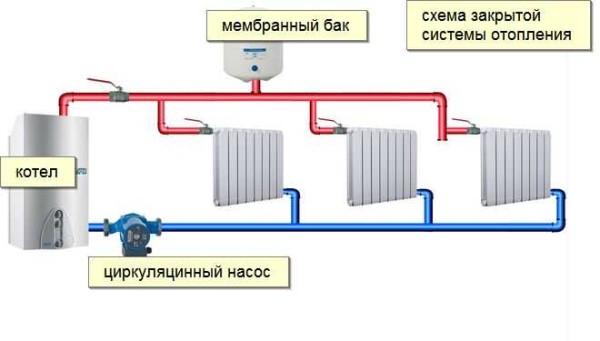
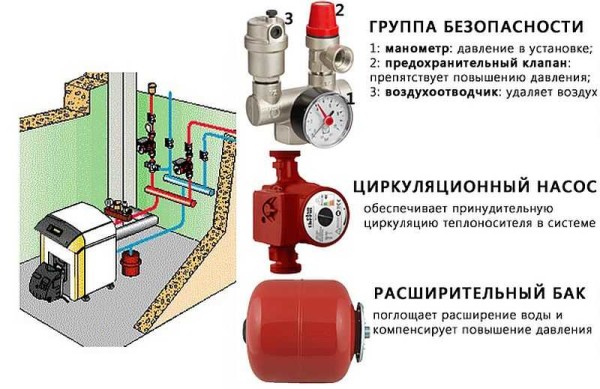
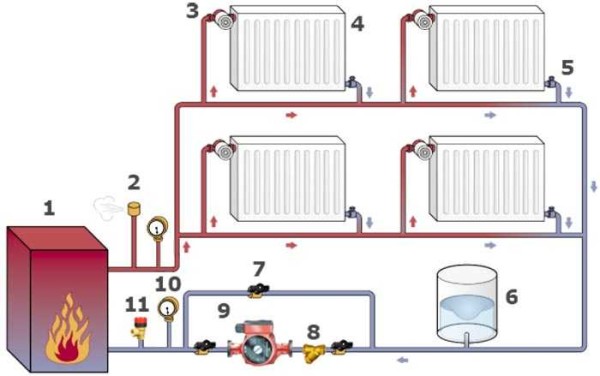
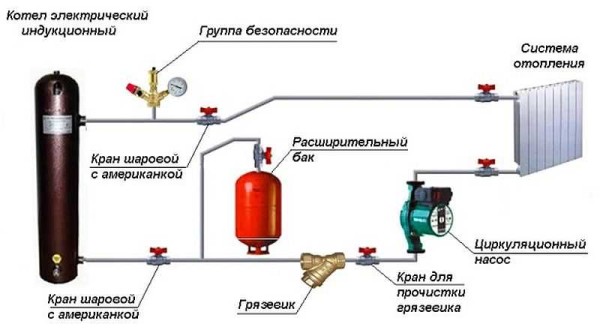
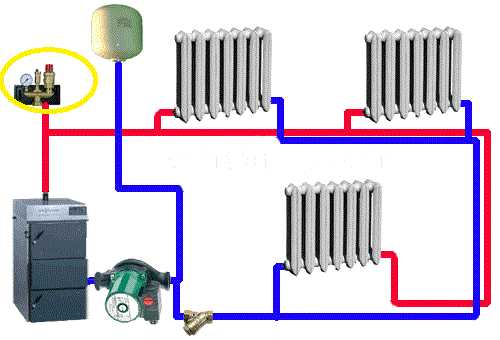

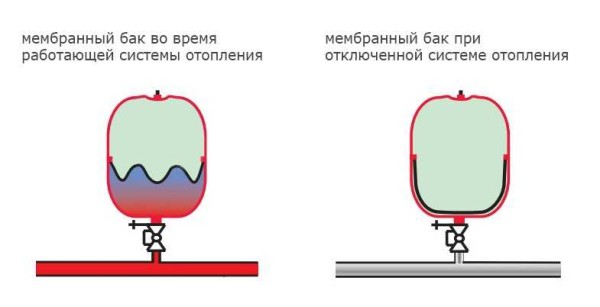
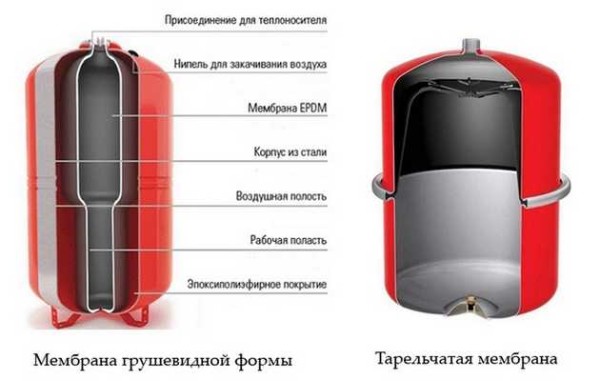
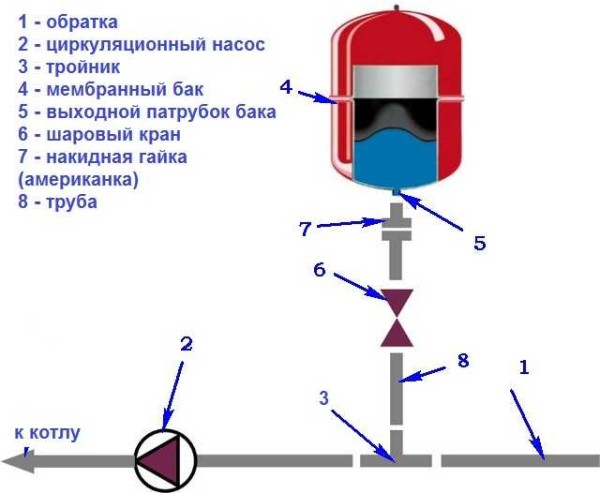
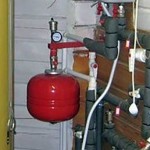
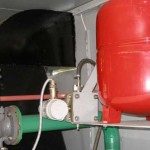
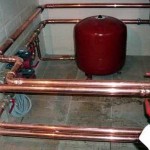
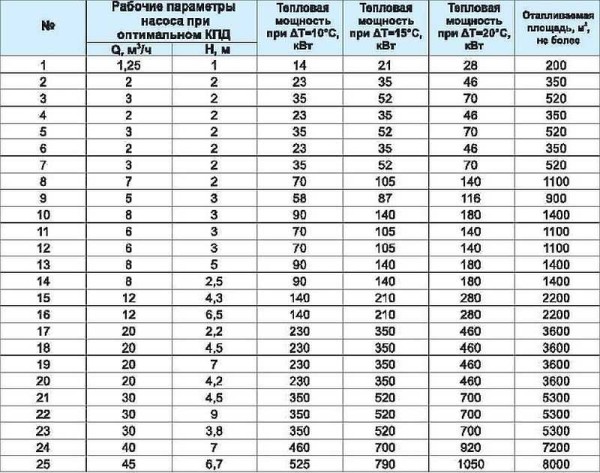

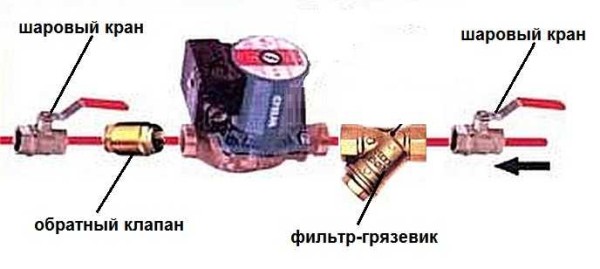
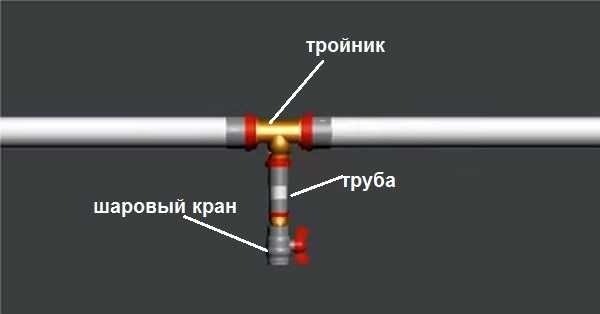
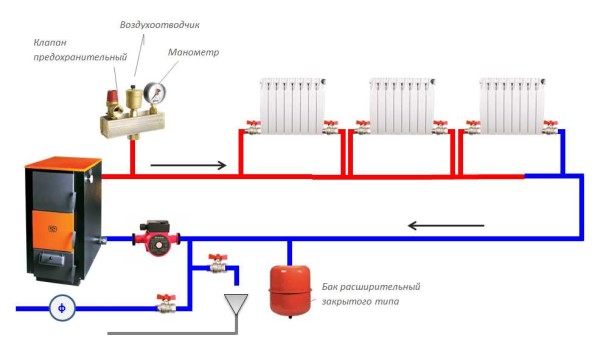
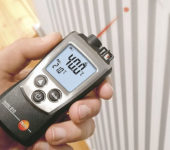
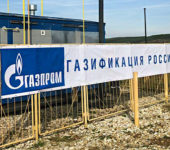
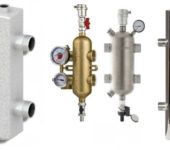

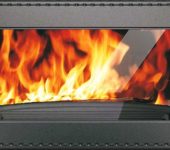





Very well scheduled. He himself is not particularly capable of repairs, but you read and it seems that everything is not as difficult as it might seem. My father-in-law put the batteries in his country house himself, not that easily, although it is possible.
Excuse me, but I cannot understand how you have compiled a table for calculating the capacity of the system?
After all, the thermal power is calculated very simply. N = 0.86 * Q * (T (straight) .- T (arr)). (KW).
I left the dimension Q and T as in your table, but nothing fits in your table. Excuse me.
I have an open system with water for more than 10 years, a circulation pump is installed, to avoid corrosion and evaporation, I poured some oil into the expansion tank. For all the time I have never added water
A story like a miracle. What is the capacity of the expander?